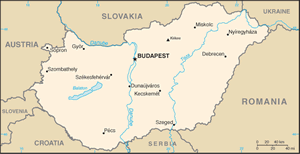The Geography of Hungary
The Geography of Hungary
Hungarian Geography
Location: Central Europe, northwest of Romania
Geographic coordinates: 47 00 N, 20 00 E
Map references: Europe
Area: total: 93,030 sq km land: 92,340 sq km water: 690 sq km
Area - comparative: slightly smaller than Indiana
Land boundaries: total: 2,185 km border countries: Austria 366 km, Croatia 329 km, Romania 443 km, Serbia 166 km, Slovakia 676 km, Slovenia 102 km, Ukraine 103 km
Coastline: 0 km (landlocked)
Maritime claims: none (landlocked)
Climate: temperate; cold, cloudy, humid winters; warm summers
Terrain: mostly flat to rolling plains; hills and low mountains on the Slovakian border
Elevation extremes: lowest point: Tisza River 78 m highest point: Kekes 1,014 m
Natural resources: bauxite, coal, natural gas, fertile soils, arable land
Land use: arable land: 49.58% permanent crops: 2.06% other: 48.36% (2005)
Irrigated land: 2,300 sq km (2003)
Natural hazards:
Environment - current issues: the upgrading of Hungary's standards in waste management, energy efficiency, and air, soil, and water pollution to meet EU requirements will require large investments
Environment - international agreements: party to: Air Pollution, Air Pollution-Nitrogen Oxides, Air Pollution-Persistent Organic Pollutants, Air Pollution-Sulfur 85, Air Pollution-Sulfur 94, Air Pollution-Volatile Organic Compounds, Antarctic Treaty, Biodiversity, Climate Change, Climate Change-Kyoto Protocol, Desertification, Endangered Species, Environmental Modification, Hazardous Wastes, Law of the Sea, Marine Dumping, Ozone Layer Protection, Ship Pollution, Wetlands, Whaling signed, but not ratified: none of the selected agreements
Geography - note: landlocked; strategic location astride main land routes between Western Europe and Balkan Peninsula as well as between Ukraine and Mediterranean basin; the north-south flowing Duna (Danube) and Tisza Rivers divide the country into three large regions


